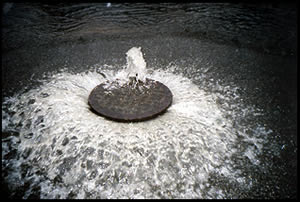Eliminating Sanitary Sewer Overflows in New England

Sanitary sewer overflows (SSOs) are releases of untreated sewage into the environment. They occur when there is an overflow, spill, or release of raw or partially-treated sewage from a sanitary sewer collection system before it reaches a sewage treatment plant. Such releases regularly contaminate our nation's waters, degrade water quality and expose humans to viruses and other pathogens that can cause serious illness. In addition, these discharges can occur as basement backups, causing property damage and further threatening public health. A combined sewer overflow or CSO is different from an SSO. More information on CSOs »
Discharges of untreated sewage from SSOs often occur due to root, grease and debris blockages, structural, mechanical and electrical failures, and extraneous flows that enter separate sanitary sewer systems due, in large part, to inadequate maintenance. An aging sewer infrastructure also increases the occurrence and severity of overflows. New England is faced with sewer systems in some communities that are more than 100 years old.
Maintaining the wastewater collection infrastructure – pump stations, force mains, and sewers – is an integral component of the proper management of a treatment system and a critical step in preventing illegal wastewater releases. Implementation of effective preventive maintenance programs has been shown to significantly reduce the frequency and volume of untreated sewage discharges.
Given the serious public health and environmental problems associated with SSOs, it is an EPA enforcement priority nationwide to identify and eliminate raw sewage discharges. EPA has taken a number of enforcement actions across the nation and throughout New England to address SSOs. These enforcement actions have resulted in the elimination of millions of gallons of raw sewage discharges and the assessment of significant penalties.
EPA New England is using both enforcement and assistance to eliminate sewage overflows and to bring municipal sewer systems into full compliance with the Clean Water Act. Our goal is to ensure that municipalities and utilities that manage wastewater collection systems meet or exceed the standards that are necessary to prevent sewer overflows and adequately manage their infrastructure.
- Use this web site to learn more about SSOs and to find links to regulatory information, technical and financial assistance resources.
More information about the causes and impacts of SSOs:
Sanitary
Sewer Overflows, USEPA Office of Water
Properly designed, operated, and maintained sanitary sewer systems are
meant to collect and transport all of the sewage that flows into them to
a publicly owned treatment works (POTW). However, occasional unintentional
discharges of raw sewage from municipal sanitary sewers occur in almost
every system. These types of discharges are called sanitary sewer overflows
(SSOs). SSOs have a variety of causes, including but not limited to severe
weather, improper system operation and maintenance, and vandalism. EPA
estimates that there are at least 40,000 SSOs each year. The untreated
sewage from these overflows can contaminate our waters, causing serious
water quality problems. It can also back-up into basements, causing property
damage and threatening public health.
Why Control
Sanitary Sewer Overflows?, USEPA Office of
Wastewater Management (pdf) (126 K)
This fact sheet describes the causes of SSOs, the extent of the SSO problem,
and the various impacts that can result from SSOs.
Report
to Congress: Impacts and Controls of CSOs and SSOs
Delivered to Congress in 2004, this report presents a comprehensive characterization
of combined sewer overflows (CSOs) and Sanitary Sewer Overflows (SSOs),
including the extent of environmental and human health impacts caused by
CSOs and SSOs, the technologies used by municipalities to address these
impacts, and the resources spent by municipalities to control CSO and SSO
discharges. The Report finds that the occurrence of CSOs and SSOs is widespread,
and that CSOs and SSOs cause or contribute to environmental and human health
impacts. Further, the Report finds that there are many existing structural
and non-structural technologies that are well-suited for CSO and SSO control.
Preventing
Backup of Municipal Sewage into Basements, USEPA Office
of Enforcement and Compliance Assurance, Enforcement Alert, September
2006
Raw or partially treated sewage can back up through pipes into businesses
and homes. Learn more about the causes of such backups and what
to do if you encounter a suspected backup.
Benefits of Protecting Your Community from Sanitary Sewer Overflows,
USEPA Office of Water, June 2000
Healthier communities, reducing community funds spent on costly clean ups
and lawsuits, keeping beaches and shellfish beds open and safe, and protecting
the infrastructure are just a few of the reasons to prevent SSOs.
Frequently Asked Questions about SSOs, USEPA Office of Water

